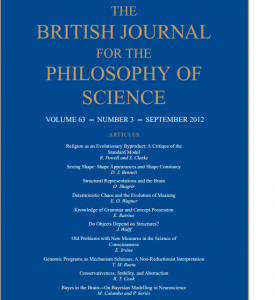Bayes in the brain. On Bayesian modelling in neuroscience
 According to a growing trend in theoretical neuroscience, the human perceptual system is akin to a Bayesian machine. The aim of this paper is to clearly articulate the claims that perception can be considered Bayesian inference and that the brain can be considered a Bayesian machine, some of their epistemological challenges, and some of their implications. We address two questions: i) How are Bayesian models used in theoretical neuroscience? ii) From the use of Bayesian models in theoretical neuroscience, have we learned or can we hope to learn that perception is Bayesian inference or that the brain is a Bayesian machine? From actual practice in theoretical neuroscience, we argue for three claims. First, currently Bayesian models do not provide mechanistic explanations; instead they are useful devices for predicting and systematizing observational statements about people’s performances in a variety of perceptual tasks. That is, currently we should have an instrumentalist attitude towards Bayesian models in neuroscience. Second, the inference typically drawn from Bayesian behavioural performance in a variety of perceptual tasks to underlying Bayesian mechanisms should be understood within the three-level framework laid out by David Marr ([1982]). Third, we can hope to learn that perception is Bayesian inference or that the brain is a Bayesian machine to the extent that Bayesian models will prove successful in yielding secure and informative predictions of both subjects’ perceptual performance and features of the underlying neural mechanisms.
According to a growing trend in theoretical neuroscience, the human perceptual system is akin to a Bayesian machine. The aim of this paper is to clearly articulate the claims that perception can be considered Bayesian inference and that the brain can be considered a Bayesian machine, some of their epistemological challenges, and some of their implications. We address two questions: i) How are Bayesian models used in theoretical neuroscience? ii) From the use of Bayesian models in theoretical neuroscience, have we learned or can we hope to learn that perception is Bayesian inference or that the brain is a Bayesian machine? From actual practice in theoretical neuroscience, we argue for three claims. First, currently Bayesian models do not provide mechanistic explanations; instead they are useful devices for predicting and systematizing observational statements about people’s performances in a variety of perceptual tasks. That is, currently we should have an instrumentalist attitude towards Bayesian models in neuroscience. Second, the inference typically drawn from Bayesian behavioural performance in a variety of perceptual tasks to underlying Bayesian mechanisms should be understood within the three-level framework laid out by David Marr ([1982]). Third, we can hope to learn that perception is Bayesian inference or that the brain is a Bayesian machine to the extent that Bayesian models will prove successful in yielding secure and informative predictions of both subjects’ perceptual performance and features of the underlying neural mechanisms.
Download articolo completo:


